
(Most recent first. Click on the titles for fuller descriptions).
27th November 2018
At this, our last meeting of 2018 the speaker was Club member Peter Stubbs who, for 35 years had practised as a solicitor, spending much of his time acting as the lawyer for a succession of defendants in criminal cases. Qualifying in 1978, his Practising Certificate was signed by none other than the redoubtable Lord Denning, Master of the Rolls.
With a series of anecdotes Peter described how he never knew from day to day what was going to happen next. He gave examples of some of the more memorable cases with which he had been involved and the variety of criminals with whom he had dealt. Some of them had been likeable, some not so, some enterprising and intelligent, some who had killed or attempted to kill, thieves, robbers and joyriders. In such a long career he had come to know several families where a criminal parent was followed in the course of time by children who became criminals themselves.
Turning to his dealings with the Police, Peter said that throughout his career he had encountered only two occasions on which he had experienced dishonesty or unprofessional behaviour by them against his clients. And, commenting on the role of the Crown Prosecution Service, he pointed out that much of the criticism levelled against it was unfair. Funding of the CPS has been cut by one-third in recent years.
Summarising his career, Peter said that it had been engrossing, enjoyable, and exciting.
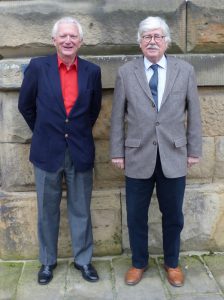
Ian Johnston and Peter Stubbs
13th November 2018
The speaker at a this meeting was one of our members, Kim Rainsford, who is Emeritus Professor of Biomedical Sciences at Sheffield Hallam University and is an internationally recognized expert in the field of analgesic and anti-inflammatory drugs. For this talk, he described the history of these particular drugs and the ways in which they had been advertised for sale to the general public.
Possibly the most familiar of this group of drugs is aspirin, which was developed in Germany in the 19th century. It was derived from chemicals, known as salicylates, that had been extracted from the bark of willow trees and which had been used for the control of various fevers for centuries. At first, aspirin was produced in a powdered form which tasted acidic and unpalatable but further developments in its manufacture resulted in many improved formulations, among them soluble types for example ‘Aspro’ (in Australia) and ‘Disprin’ (in the UK). Closely related analgesic and anti-inflammatory drugs are paracetamol, ibuprofen and others, all of which are freely advertised for direct sale to the public.
As Kim explained, he has been involved throughout his career in researching the safety and efficacy of these drugs and their side-effects. Among his concerns has been the aggressive way that many have been advertised, especially by manufacturers whose primary management focus has been on marketing rather than the scientific aspects of their businesses.
He concluded his talk by showing examples of the huge number of differently packaged and marketed painkiller remedies that are available ‘over-the-counter’. As he pointed out, many of these, although identical in formulation, vary widely in price.
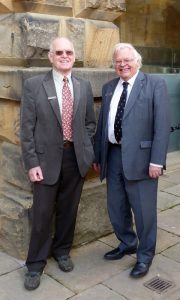
Tony Byrne and Kim Rainsford
23rd October 2018
At this, our 2018 AGM, the meeting was held at our new venue, the Burlington Room at Chatsworth. Founded in 1984, the Club has now entered its 35th year and today the chairmanship was handed over from Ray Smith to Ian Johnston who then introduced the speaker, club member John Robinson.
John is a member of the Robinson family whose business, Robinson & Sons Ltd of Chesterfield was inaugurated in 1839 and started by manufacturing pillboxes. In 1854, it expanded its operations to include making lint. The demands of the Crimean War (1853-56) initiated future surgical dressings developments. Later still, Robinsons became the world’s first manufacturer of sanitary products.
The company flourished and, in 1939, to mark the centenary of the business its directors organised a day excursion from Chesterfield to London for all of its 3,704 employees. As John explained, this was a huge undertaking. Because of the numbers involved, no fewer than eight special trains had to be arranged to accommodate them all, and on arrival in London, each train was met by nine double-decker buses to take its passengers variously to the Tower of London, Westminster Abbey and, for the younger workers, the Zoo. Breakfast was provided on the trains in the morning, lunch and tea at Lyons Corner Houses during the day, and supper on the return train journey. For entertainment, the company had hired the Albert Hall for an evening programme of variety acts.
The entire trip cost Robinsons £5,686 which, at today’s values, would equate to £300,000. However, it is questionable if a similar outing could be arranged these days; apart from the cost, it would be a logistical nightmare to try and organise all the transport, catering and entertainment for so large a group of people.
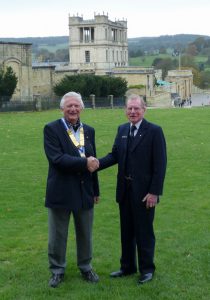
Ian Johnston and Ray Smith
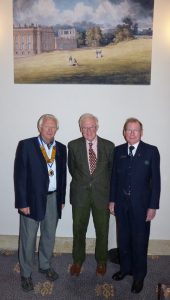
Ian Johnston, John Robinson and Ray Smith
9th October 2018
Lying between the Scottish mainland and the Isle of Skye, the Hebridean island of Raasay was the subject of this talk by one of our members, Don Mackenzie. The speaker had first visited Raasay in 1968 for an eight week stay, during which time he was to carry out a geological mapping project as part of his undergraduate studies. At that time, he found the place to be a very traditional, remote highland community, deeply religious and conservative. The Sabbath was strictly observed, as illustrated by a sign banning the use of the children’s playground on Sundays.
Fifty years on, Don returned to the island this summer and witnessed many changes that had taken place over the intervening period. Access was considerably easier thanks to the introduction of roll-on roll-off vehicle ferries operating more frequently over a shorter route from Skye. On the island itself he found new housing and community buildings. The Laird’s seat, Raasay House, famously visited by Boswell & Johnson in 1773, is now an hotel. A new whisky distillery, sourcing its water and some of its raw materials locally has been established and will be in full production by 2020.
To illustrate the changes that he saw, and to place them in the context of Raasay’s remarkably varied and complex geology, the speaker showed a series of photographs and maps covering a tour around the whole island. This was a fascinating talk about a little-known part of our country.

Don Mackenzie and Ainslie Kelly
25th September 2018
Always a topic for analysis and debate, the current state and future of the NHS was the subject of this talk by one of our members, Stefan Andrejczuk. With a background career first in the retail sector and, subsequently, in several senior positions in healthcare management, the speaker was well qualified to discuss the problems now faced by the NHS. These include pressures created by the aging population, budget cuts, staff shortages, and an increasing demand for social care.
It was to help in the provision of social care that, on his retirement, Stefan joined our local charity ‘Helen’s Trust’ by becoming its Chief Executive Officer, thereby adding his leadership and organisational experience to the existing team. In his talk, he described the history of Helen’s Trust and its aim which is to give people with terminal illness the choice to stay at home surrounded by their family and friends in their final stages of care. He went on to outline the Trust’s plans for its continuing development.
The speaker then discussed one of the NHS’s major problems, which is the decline in the number of General Practitioners and, as a consequence, the closure of many surgeries. He suggested that, to help overcome this shortage, new technology in the form of a mobile phone ‘app’ could be developed to allow the user to gain access – at any time and from anywhere in the world – to a fully qualified doctor for an over-the-phone consultation. Technology of this type is already in use in several other countries, but whether it would gain favour here was a question debated at length by the speaker’s audience at the conclusion of his absorbing talk.
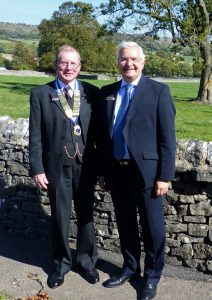
Ray Smith and Stefan Andrejczuk
11th September 2018
On reaching retirement, many people put their work experience to good use by taking up voluntary activities related to their former occupation. An example was given at this meeting when club member, Brian Barry, whose career had been in engineering, talked about an organisation, ‘Remap’ in which he has been involved for several years. Officially, Remap is an acronym for Rehabilitation Engineering Mobility Advisory Panels but, a more apt version would probably be Retired Engineers Making Aids for People. It is a nationwide charity of over seventy semi-autonomous ‘panels’, each of which is responsible for designing and making items of equipment tailored to the individual needs of local disabled people.
As one of the two dozen volunteers working with the Derby, Burton and District Panel, Brian showed photographs of some of the many mobility aids produced by himself and his colleagues. These ranged from the simplest things, such as a wheelchair small enough for use in confined spaces, to more complex appliances, one of which is a machine for turning the pages of a book for someone unable to do so by hand. Probably the most satisfying items of equipment are those made for disabled children, whose lives can be transformed by the ingenious solutions to their particular needs.
Over the past five years, the local panel has designed and manufactured (or modified) approximately seven hundred aids for people with disabilities and their carers – a most worthwhile contribution to the wellbeing of this group of people and one which helps, in some way, to make their lives easier.

Ian Johnston and Brian Barry
28th August 2018
For many people with an interest in their own ancestry, the research and detective work involved in tracing their roots can prove to be an absorbing pastime but it can often be frustrating and confusing. Examples of the difficulties which a researcher may encounter were described at this meeting by club member, Roger Truscott.
Roger was born in South Wales but neither of his parents was local to the area. They had both been drawn there in the early 20th century by the prospect of getting employment; his father from Cornwall and his mother from Bristol. Of course, this much of his family history was well known to him, as was that of his grandparents, but it was when he delved into earlier generations that Roger started to encounter problems. In particular, the lineage of his maternal grandmother proved fiendishly difficult to unravel. Eventually, through all the documentation available to him (such as the 10-yearly Census results, registers of births, marriages and deaths, and parish records), he discovered a sometimes murky story of unmarried couples (in the days when cohabitation was definitely taboo), bigamy, theft and imprisonment. Much of his research was done before information was available via the internet.
This was an extremely entertaining talk, delivered with humour and enthusiasm, and it was well received by the audience.
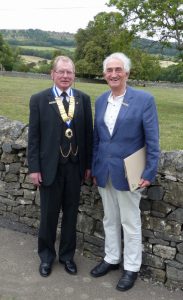
Ray Smith and Roger Truscott
14th August 2018
A fundamental principle of the Probus organisation is that all members must be retired or semi-retired. Therefore, when the speaker at this meeting talked about taking up a new interest in retirement, his audience was intrigued. How had our fellow member John Thurstan, approached the challenge of finding things to occupy his time after finishing his busy working life? He already had many interests but, like so many of his generation, he had grown up in the days when, through books such as ‘Biggles’ and comics like ‘The Eagle’, flying was seen to be exciting and glamorous. Hence, when he retired, John took advantage of his increased leisure time and decided to take up flying himself.
Being satisfied that he was physically and mentally fit enough to fly and that he had sufficient time and money to do so, he chose to learn on a microlight plane. These aircraft are lightweight, slow-flying and subject to minimum regulations.
At first accompanied by an instructor, John gained sufficient experience to be granted a flying licence after 34 hours of flying. He described the many safety checks to be made before taking off and the procedures to be followed during flight and on landing. Finally, to demonstrate how it feels to fly in one of these microlights, he showed a series of video clips he had taken during a flight from his base at Darley Moor Airfield near Ashbourne.
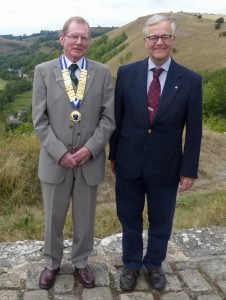
Ray Smith and John Thurstan
24th July 2018
At our twice-monthly meetings, we are fortunate to hear talks on a wide range of topics from speakers who prove to be experts in their particular fields of interest. Such was very much the case at today’s meeting when the speaker was club member Malcolm Cameron whose subject was Royal Crown Derby. The title of his talk included the phrase “A Passion!”, and it soon became clear to his audience that here was someone who was not only an enthusiastic collector of the products of this famous manufacturer of fine porcelain but also an expert on all aspects of the company, to the extent that the results of his own research have been incorporated into Royal Crown Derby’s official archive.
Starting his talk with a history of the company from its origins in 1750, through a number of different ownerships and factory sites to the present day, Malcolm went on to describe the types of products made over the years. From the earliest days, one of the most popular designs of decoration has been the Japanese-inspired Pattern No. 1128, known as “Imari”, which is probably the design most often associated with Royal Crown Derby. As one of his huge collection of porcelain pieces, Malcolm showed his audience a plate to this design with, as a unique feature on the bottom of the plate, the signatures of all those involved in its production.
Over such a long history, the company had periods of decline but it succeeded in overcoming these, usually by changing ownership or by employing talented artists of the day. Its status was enhanced by royal patronage, firstly by King George III, and then, in 1890, by Queen Victoria who granted it permission to add the word “Royal” to its title.

Ray Smith and Malcolm Cameron
10th July 2018
Introduced by Vice Chairman Ian Johnston, the speaker at this meeting was fellow club member, Peter Coffey. Having spent his career at Lloyd’s of London, Peter was highly qualified to talk on the subject of insurance, its history and the way in which this particular sector of financial business operates. As he described, Lloyd’s can trace its origins back to the coffee houses of the 17th century where entrepreneurs and merchants met together to exchange news and information about shipping. From these beginnings, the business developed and expanded to the point at which, in 1928, it moved into its first purpose-built offices in Leadenhall Street, London. Due to continuing expansion, a further move was made in 1986 when the futuristic and sometimes controversial New Lloyd’s building was inaugurated.
Peter had retired as a Lloyd’s underwriter in 1997 but, by that time, he had seen significant changes in the way that the insurance business had developed. Originally, the system had been that underwriters were private individuals (known as ‘Names’) who could demonstrate that they had sufficient assets to cover any potential losses. However, in the later years of the 20th century, their place was beginning to be taken by limited liability syndicates. In spite of this trend, there still remain some 200 Names, handling approximately 10% of Lloyd’s business.
Peter concluded his talk by responding to a lengthy session of questions from his audience.
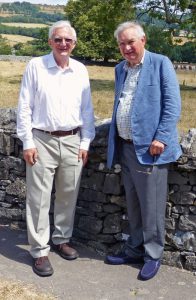
Ian Johnston and Peter Coffey
26th June 2018
“A patient, persistent, perceptive, progressive and philanthropic perfectionist; an engineer with local connections who left an immense legacy” was the description of Sir Joseph Whitworth who was the subject of a talk given by today’s guest speaker, Stephen Coates.
As Stephen told us, Joseph Whitworth was born in Stockport in 1803 and grew up at a time when many of his contemporary engineers were working to devise methods of improving the accuracy and standardisation of machines and their components. At the age of fourteen, Whitworth was apprenticed at his uncle’s mill near Ambergate and soon showed considerable aptitude for this sort of work. Wishing to expand his experience he moved to a factory in Manchester and then to London where he was employed by Henry Maudslay, a prominent innovator who recognized Whitworth’s talent in designing and making accurate machine tools.
Returning to Manchester in 1833, Whitworth set up his own business. Here, amongst many other activities, he designed a standard thread for nuts and bolts (the ‘Whitworth Thread’) and he developed an improved version of the Enfield rifle. Meanwhile, he bought Stancliffe Hall in Darley Dale and moved there with his second wife, Louisa, in 1872.
Doubtless influenced by the notable philanthropist Robert Owen, Whitworth was a strong believer in technical education and the general improvement of the lives of working people. Although completed by his wife after his death in 1887, the Whitworth Institute and the Whitworth Hospital, serve as local reminders of this remarkable man.

Ray Smith and Stephen Coates
12th June 2018
The remarkable story of a little-known British naval expedition during World War I was the subject of this talk by club member, Alan Grant. At the outbreak of war in 1914, Germany held territory in Tanganyika (now Tanzania), and had designs on adjacent lands held by Britain (Rhodesia) and Belgium (Congo). In order to achieve its aims, Germany would have to gain control of Lake Tanganyika (which formed the boundary between Congo and Tanganyika) and it was to counter this threat that the British devised a plan to transport two small warships all the way from England.
High-speed motor launches (40 feet in length) were chosen as being the most appropriate for the job. As Royal Navy vessels, these had to be given names, and those originally proposed by the eccentric leader of the expedition, Lieutenant Geoffrey Basil Spicer-Simson, were HMS Cat and HMS Dog. However, this choice of names was judged unacceptable by the Admiralty and so, not to be completely thwarted by the authorities, Spicer-Simson named them HMS Mimi and HMS Toutou (meaning ‘cat’ and ‘dog’ in French slang).
With the aid of contemporary photographs, Alan described how these boats were taken as cargo by sea to Cape Town; thence by rail to the end of the line beyond Elisabethville in Congo. From here they were loaded on to trailers and hauled overland for 146 miles by traction engines and oxen, eventually arriving on the shores of Lake Tanganyika some six months after leaving England.
Once afloat they went in pursuit of one of the German ships already on the lake and, after a fight, forced it to surrender. Now in British hands, it was renamed HMS Fifi and it joined forces with Mimi and Toutou to attack a second, larger German ship, Hedwig von Wissmann, which, in turn, was put out of action. With their mission accomplished, the crews of the British ships returned home and, with the defeat of Germany, Tanganyika became a British territory in 1922.

Ray Smith and Alan Grant
22nd May 2018
The talks given to our Club cover a broad spread of subject matter and geographical locations. In contrast to the previous meeting, when the subject of the talk had been the country of Japan, we were brought much closer to home at this meeting when the speaker, Club member Michael Hall, described the part which he had played in the creation of the University of Derby from a collection of separate institutions.
From as early as the 1850s, when an establishment for the training of schoolmistresses was founded, a number of colleges of further education were developed in and around Derby. These included a School of Art, a Technical College and a College of Nursing. In time, it became clear that if these various centres of further education were to reach their full potential and, by amalgamating with each other, achieve university status there would have to be significant reorganisation and expansion.
As he explained, Michael was very much involved in helping to drive this process which required the acquisition and development of numerous properties (some of them former factories) for the purposes of providing teaching and residential facilities for many more students. The result of these efforts has been to provide the city and county of Derby with a university of which to be justly proud.
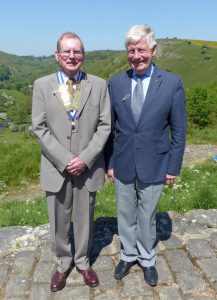
Ray Smith and Michael Hall
8th May 2018
Situated in the direction of the rising sun, as seen from continental Asia, this is the name by which the group of islands forming Japan is often known; and it was the subject of today’s talk by club member Ron Marshall. His youngest son has lived in Tokyo for the last fourteen years and it was this family connection which had led to him and his wife, Sandra, making several visits to the country. They have always found the Japanese to be a little formal and conservative, but always very courteous, friendly and welcoming.
Starting his talk with a brief description of the geography of Japan, Ron described how almost three quarters of the land area is mountainous and that over two thirds is covered in forest. These facts help to explain why the population is concentrated around the coasts, especially in the Tokyo area where there are 38 million people.
One of Japan’s most notable features is Mount Fuji, a volcano now dormant for over 300 years and a place greatly revered by the Japanese. Ron and Sandra had successfully climbed to its summit which, at 12,388 feet, is Japan’s highest. He concluded his talk by showing a video clip of kabuki theatre. This is a dance-drama in which the actors wear elaborate make-up and costumes and act with exaggerated movements and gestures.

Ron Marshall and Ray Smith
24th April 2018
With the sub-title ‘David Catton eats for Britain’, this talk, given by one of our own members was a fascinating insight into the variety of food to be found in the different countries and regions of the world. Illustrating his talk with photographs of the sort of dishes presented to him and which he had eaten in over fifty countries, the speaker was clearly an adventurous gourmand, eager to sample whatever may have been on the menu, no matter how unusual the food on offer may have been.
Starting his talk by showing pictures of the more familiar national specialities, such as haggis in Scotland and queenie scallops in the Isle of Man, the speaker led his audience on a gastronomic tour from North America, through Europe and Africa, to Asia and Australia; prompting his talk with many amusing anecdotes on the way. On his travels he had eaten prime rib steak in the USA, bear meat in Finland, whale meat in Norway, crocodile in Botswana and seafood in a multitude of places. Possibly one of the more memorable offerings had been a platter of cooked whole frogs (not just the legs) in Switzerland. As well as exotic types of meat, he had sampled numerous vegetable dishes, soups and desserts.
Here was a man determined to try, and usually enjoy, the types of food eaten by the natives of whichever country he happened to be visiting.
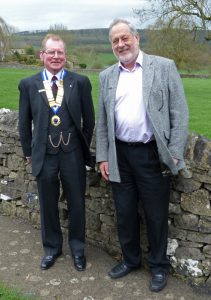
Ray Smith and David Catton
10th April 2018
This talk was given by club member, Brian Fearn who, as well as an expert on cacti and succulents, is a knowledgeable and keen motoring enthusiast. In an earlier talk, he had described how he and his navigator had taken part in the 1991 Monte Carlo Winter Challenge in Brian’s 1937 Aston Martin 2-litre Sports.
On this occasion, keeping to his theme of motoring, he related the history of the Brooklands motor racing circuit in Surrey, which was opened in 1907 as the world’s first purpose-built circuit. The site was also one of Britain’s first airfields and a manufacturing centre for aircraft. The main purpose of the circuit was for the high speed testing of cars and to cater for these speeds, the curves were banked. In places the banking was up to 30 feet high.
Prior to the outbreak of World War I, the venue witnessed a number of motoring records being set, both in terms of speed and endurance but, with the outbreak of war, the circuit was closed to motor racing.
Motor racing resumed in 1920 and in 1926, the British Grand Prix was staged there. Throughout the 1920s and 1930s, motor racing continued but, on the outbreak of war in 1939, the track was closed again – this time never to be reopened for racing.
27th March 2018
It may come as a surprise to many people that the oldest international sporting trophy is held not for one of the more popular participatory sports such as football, cricket or athletics but for the much more exclusive sport of sailing. At this meeting the story of this competition was told by a guest speaker, Richard Carter, who described how in the mid-19th century, wealthy British yacht owners arranged to race each other at regattas on the South Coast of England. Then, in 1851, a yacht ‘America’ sailed across the Atlantic to take part in that year’s race around the Isle of Wight. By enlisting the help of a highly experienced local crew member (and, it is claimed, by a certain amount of cheating), ‘America’ actually won; and the trophy, formerly known as the “£100 Cup” was renamed “The America’s Cup” in honour of that yacht.
Since that time, the format of the races has been that two sailing yachts, one representing the club ‘defending’ the trophy and the other the ‘challenger’ have competed at varying intervals. For more than 120 years, the New York Yacht Club’s series of yachts defending the America’s Cup was unbeaten but in 1983, an Australian challenger finally broke through and thereby became the new ‘defender’ of the Cup. In recent years, after several more challenges, the Cup has been held by the Royal New Zealand Yacht Squadron who will be defending it in 2021.
During his talk, Richard showed how the design, development and consequential cost of these racing yachts has evolved over the years, to the extent that they may now be considered the equivalent, in sailing terms, of Grand Prix Formula 1 cars.
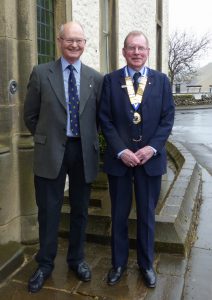
Richard Carter and Ray Smith
13th March 2018
The annual debate this year took as its topic the motion that ‘This club believes that the current generational inequality is unfair’. The two club members leading the debate were John Broughton who supported the proposition and Jonathan Wicksteed who opposed it. A vote among the members present before the debate showed that eight members were in agreement with the proposition and seventeen were against. Following the opening submissions, the debate was continued with numerous contributions from the floor. However, it would appear that the debate failed to sway opinion one way or the other because, at its conclusion, the total numbers voting for and against the motion remained substantially unchanged.
13th February 2018
Today’s speaker was club member, Ken Watson, and the topic of his talk was the history of opera. Posing the question, “Why on earth do people like opera?” he pointed out that it had been described as ‘an exotic and irrational entertainment’, often with unlikely plots and with singers whose physical appearance was totally at odds with the character portrayed. As an example, in Puccini’s La Bohème, the hero sings “Your tiny hand is frozen” to the heroine who, in many performances, is likely to be an extremely large lady. An added difficulty for British audiences was that the earliest operas were invariably in a foreign language that not many people could understand. It was not until 1983, when surtitles were introduced, that better understanding arose.
Ken described how this art form had originated in Florence in the 16th century when nobility, poets and musicians used to go and see a play together. The acts of the play used to be interspersed with intermezzi and in 1598 they strung the whole performance together and called it opera. In 1637 the first public opera house opened in Venice. Most operas were based on characters from classical history or classical mythology.
By the 18th century the first English language operas started to take over from Italian, French and German. The plots were more varied and choruses started to be used. By the beginning of the 19th century French “Grand Opera” developed with huge casts. In Italy “Bel Canto” held the stage. Closing his talk, Ken returned to his initial question and gave the answer, “for the music”, of course!
23rd January 2018
On a foggy night in March 1943 an RAF Lancaster bomber, returning from a mine-laying mission over the west coast of France, crashed while attempting to land at an airfield in the Vale of Belvoir, killing six of its seven crew members. During wartime there were many such tragedies but, as related by club member David Webb, this particular disaster became the subject of detailed research carried out almost seventy years later by a group of residents from the village, Plungar, near where the crash happened. This investigation was prompted by the discovery in 2010 of some aircraft wreckage when a local farmer was ploughing the field where the plane was known to have come down.
Drawing on a number of sources, the speaker and his colleagues were able to establish the most likely causes of the crash and they identified the names and nationalities of the seven crew members, of whom there were two Canadians, one Barbadian and the others British. They concluded that the aircraft had been damaged by enemy fire on its return from France and that its crew had become disorientated in the fog whilst attempting to land at a nearby RAF base.
As a tribute to the victims of the crash, in 2012 the researchers organised a memorial service at the village church, followed by a flypast of the Battle of Britain Memorial Flight and they later commissioned and erected a permanent memorial headstone alongside the crash site.

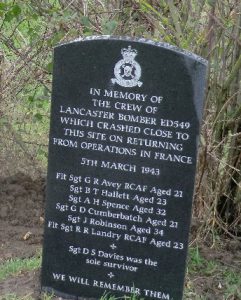
Ray Smith and David Webb, and the Memorial to the crew of Lancaster ED549
9th January 2018
When we learn that the speaker at one of our meetings is to be Club member, Ian Johnston, we can be confident that we will hear an informative and amusing talk. Such was the case at this, the first meeting of the New Year, when Ian spoke about industrial relations, talking not only about the history of the trade union movement but also drawing on his personal experience from the days when he was a member of the Civil Service.
It was with the Industrial Revolution that workers joined forces to create the first trade unions. Their aim was to improve the working and safety conditions in factories and other places of work. Initially, these bodies were outlawed, until 1825, but thereafter they became accepted as legitimate organisations. Over time, their influence and power increased to such an extent that by the 1960s and 1970s the question was being asked, “Who rules Britain — the unions or the Government?”
This was the time at which our speaker joined the Department of Employment and worked on a number of initiatives to improve the industrial relations between employers and their workers. He was involved in drafting much of the industrial relations legislation for several years and played a senior role in ACAS (The Advisory, Conciliation and Arbitration Service). In 1985 he was appointed Finance Director of the Manpower Services Commission, a position which he held until he left the Civil Service to pursue a new career in higher education.

Ian Johnston and Ray Smith

© Bakewell and District Probus Club, 2014-2024